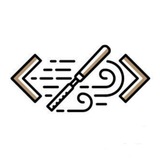Forwarded from Pythonic Dev ( Sadegh)
📢 Understanding the Callstack in Programming! 📚
Welcome, fellow developers, to another insightful post on our Telegram channel! Today, we dive into an important concept in programming - the "Callstack." 🔄
💡 What is a Callstack?
A callstack, also known as an execution stack, is a fundamental concept in computer science that helps us understand how programs execute and keep track of function calls. When a function is called, its execution context is added to the top of the callstack, and when that function completes, it is removed from the stack. Essentially, the callstack keeps track of where we are in the execution of a program.
🧮 How does the Callstack work?
Imagine you have a Python program that calls multiple functions. Each time a function is called, its execution context is added to the callstack. This includes variables, parameters, and the return address of the calling function. When the called function completes, its execution context is removed from the stack, and the program continues from where it left off in the calling function.
🔍 Why is the Callstack important?
Understanding the callstack is crucial for debugging, as it helps us trace the flow of our program, identify the order in which functions are executed, and identify any potential issues such as infinite recursion or stack overflow. By examining the callstack, we can gain valuable insight into how our program behaves and find the root cause of any unexpected behavior or errors.
📝 Key points about the Callstack:
1️⃣ The callstack follows the Last-In-First-Out (LIFO) principle, meaning the most recently called function is at the top of the stack.
2️⃣ Recursion occurs when a function calls itself, adding multiple instances of the same function to the callstack.
3️⃣ If the callstack becomes too large, it can result in a stack overflow, causing the program to terminate unexpectedly.
🔧 How can we use the Callstack to our advantage?
1️⃣ By examining the callstack during debugging, we can better understand the sequence of function calls and potentially identify any missed or incorrect function invocations.
2️⃣ Understanding the callstack can help us optimize our code by avoiding unnecessary function calls or reducing recursion depth.
3️⃣ The callstack can be a useful tool for identifying and fixing memory-related issues in our programs.
Remember, as you delve deeper into your programming journey, always pay attention to the callstack. It holds the key to understanding the intricacies of function calls and program execution!
🌟 Stay curious, keep learning, and keep coding! Feel free to share your thoughts or ask any questions in the comments below. Happy coding, everyone! 🐍💻
#CallStack
#Python
@Pythonic_Dev
Welcome, fellow developers, to another insightful post on our Telegram channel! Today, we dive into an important concept in programming - the "Callstack." 🔄
💡 What is a Callstack?
A callstack, also known as an execution stack, is a fundamental concept in computer science that helps us understand how programs execute and keep track of function calls. When a function is called, its execution context is added to the top of the callstack, and when that function completes, it is removed from the stack. Essentially, the callstack keeps track of where we are in the execution of a program.
🧮 How does the Callstack work?
Imagine you have a Python program that calls multiple functions. Each time a function is called, its execution context is added to the callstack. This includes variables, parameters, and the return address of the calling function. When the called function completes, its execution context is removed from the stack, and the program continues from where it left off in the calling function.
🔍 Why is the Callstack important?
Understanding the callstack is crucial for debugging, as it helps us trace the flow of our program, identify the order in which functions are executed, and identify any potential issues such as infinite recursion or stack overflow. By examining the callstack, we can gain valuable insight into how our program behaves and find the root cause of any unexpected behavior or errors.
📝 Key points about the Callstack:
1️⃣ The callstack follows the Last-In-First-Out (LIFO) principle, meaning the most recently called function is at the top of the stack.
2️⃣ Recursion occurs when a function calls itself, adding multiple instances of the same function to the callstack.
3️⃣ If the callstack becomes too large, it can result in a stack overflow, causing the program to terminate unexpectedly.
🔧 How can we use the Callstack to our advantage?
1️⃣ By examining the callstack during debugging, we can better understand the sequence of function calls and potentially identify any missed or incorrect function invocations.
2️⃣ Understanding the callstack can help us optimize our code by avoiding unnecessary function calls or reducing recursion depth.
3️⃣ The callstack can be a useful tool for identifying and fixing memory-related issues in our programs.
Remember, as you delve deeper into your programming journey, always pay attention to the callstack. It holds the key to understanding the intricacies of function calls and program execution!
🌟 Stay curious, keep learning, and keep coding! Feel free to share your thoughts or ask any questions in the comments below. Happy coding, everyone! 🐍💻
#CallStack
#Python
@Pythonic_Dev
👍1
